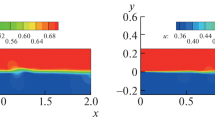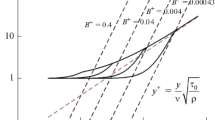Abstract
The art of “modeling turbulence” is a needed tool in the construction of computer codes for turbulent flows. The state to which this art has been developed is inadequate, and quotations from authoritative sources support this point of view. The energy contained in the turbulent fluctuations, i.e., the turbulent energy, is often used as a parameter in the modeling process. The present article attempts to examine this quantity as it is being created, transported, and dissipated. For this purpose experimental evidence from the author's own experiments (free jets), as well as theoretical conclusions from the elementary deductions of the basic equations, the concept of turbulent potential flow, and a general solution to the Navier-Stokes-Reynolds equations, is drawn to attention. Recirculating flow is given special attention. The paper concludes with recommendations for principles that must be satisfied if improved modeling is to be achieved. These principles are necessary; whether they are also sufficient is open to question.
Similar content being viewed by others
Abbreviations
- A 0 :
-
Constant
- b 1/2 :
-
Jet's half-width
- b 2/(0)1 :
-
Jet's half-width at z=z(in0)
- E z :
-
Kinetic energy contained in the jet's axial velocity at a given profile
- E r :
-
Kinetic energy contained in the jet's radial velocity at a given profile
- f(η) :
-
Dimensionless velocity profile [f(0)=1]
- F(η), H(η):
-
Defined functions
- L char :
-
Jet's characteristic length
- m, n :
-
Exponents
- p :
-
Pressure
- q :
-
Kinetic energy in the turbulent fluctuations
- \(\vec q\) :
-
Heat flux
- q 2 :
-
\( = \overline {u'u'} + \overline {\upsilon '\upsilon '} + \overline {w'w'}\)
- r, φ, z :
-
Cylindrical coordinates
- t :
-
Time
- û :
-
Internal energy
- u, v, w :
-
Velocity components
- \(\bar u,\bar \upsilon ,\bar w\) :
-
Mean velocity components
- \(\bar \upsilon _r ,\bar \upsilon _\phi ,\bar \upsilon _z\) :
-
Mean velocity components
- U 0 :
-
Constant
- U plate :
-
Plate's velocity
- Uskc/(0) :
-
Centerline velocity at z=z0
- X, Y, Z :
-
Components of body force
- W :
-
Total work done by surface stresses
- W 1 :
-
Recoverable work done by surface stresses
- W 2 :
-
Dissipated work
- z 0 :
-
Downstream distance from the nozzle beyond which self-similar velocity profiles occur
- ν:
-
Fluid's kinematic viscosity
- ρ :
-
Fluid's density
- \(\left. {\begin{array}{*{20}c} {\sigma _x } \\ {\sigma _y } \\ {\sigma _z } \\ \end{array} } \right\}\) :
-
Normal stresses
- \(\left. {\begin{array}{*{20}c} {\tau _{xy} } \\ {\tau _{yz} } \\ {\tau _{zx} } \\ \end{array} } \right\}\) :
-
Shear stresses
- \(\left. {\begin{array}{*{20}c} {\sigma _x^0 } \\ {\sigma _y^0 } \\ {\sigma _z^0 } \\ \end{array} } \right\}\) :
-
Normal stresses with the pressure removed
- \(\left. \begin{gathered} \eta = y/\sqrt {\omega /2v} \hfill \\ \eta = y/b_{1/2} \hfill \\ \end{gathered} \right\}\) :
-
Dimensionless Crossflow coordinate
- η0 :
-
Constant
- \(\left. {\begin{array}{*{20}c} {\chi _1 } \\ {\chi _2 } \\ {\chi _3 } \\ \end{array} } \right\}\) :
-
Stress functions
- Λ :
-
“Stress potential”
References
W. J. McCroskey, P. Kutler, and J. O. Bridgeman, AGARD Structures and Materials Panel Specialist' Meeting on “Transonic Unsteady Aerodynamics and its Aeroelastic Applications,” Sept. 3–5 (1984), Paper No. 9.
C. Bouffinier and M. Grandotto, Commissariat à l'Énergie Atomique, Cadarache, France, Proc. Int. Symp. Refined Turbulence Model. Turbulence Measure., C11, University of Iowa, Ames, Sept. 16–18 (1985).
J. Kestin, Boundary Layer Theory (translation of H. Schlichting's book) (McGraw-Hill, New York, Toronto, London, 1960), pp. 75–76.
L. N. Persen, AGARD Conference Proceedings No. 308, Symposium on Fluid Dynamics of Jets with Applications to V/Stol, Lisbon, Portugal, Nov. 2–5 (1981).
L. N. Persen, DGLR-Vortrag Nr. 81-013, Jahrestagung der DGLR, Aachen, May 11–14 (1981).
L. N. Persen, Turbulence Research, Trends in Heat Mass & Momentum Transfer, 2 (1992), pp. 223–235.
J. L. Lumley, in Proceedings of a Workshop Held at Cornell University, March 22–24, 1989, Lecture Notes in Physics (Springer Verlag, Berlin, Heidelberg, New York, London, Paris, Tokyo, Hong Kong, 1990), pp. 1–4, 49–56.
L. N. Persen, in Progress in Aerospace Sciences, Vol. 23, No. 3 (Pergamon Press, Oxford, New York, Beijing, Frankfurt, Sao Paolo, Sydney, Tokyo, Toronto, 1986), pp. 167–183.
Author information
Authors and Affiliations
Additional information
Paper dedicated to Professor Joseph Kestin.
Definitions of symbols are given under Nomenclature.
Rights and permissions
About this article
Cite this article
Persen, L.N. A note on the turbulent energy as a parameter of turbulent flow. Int J Thermophys 14, 637–659 (1993). https://doi.org/10.1007/BF00502099
Received:
Issue Date:
DOI: https://doi.org/10.1007/BF00502099




